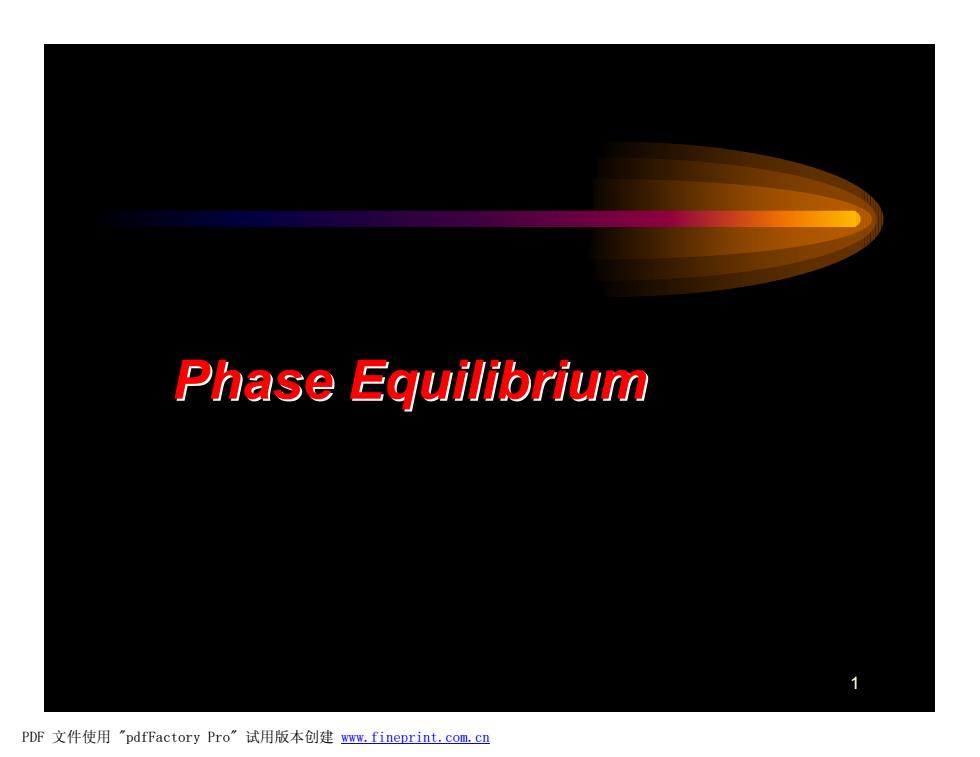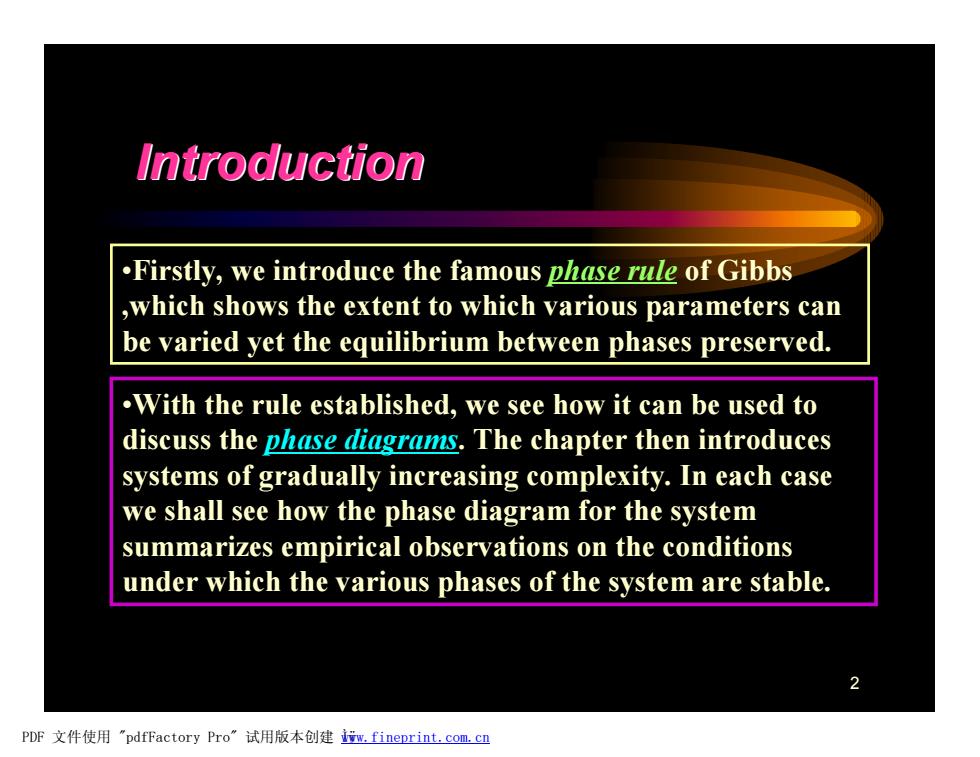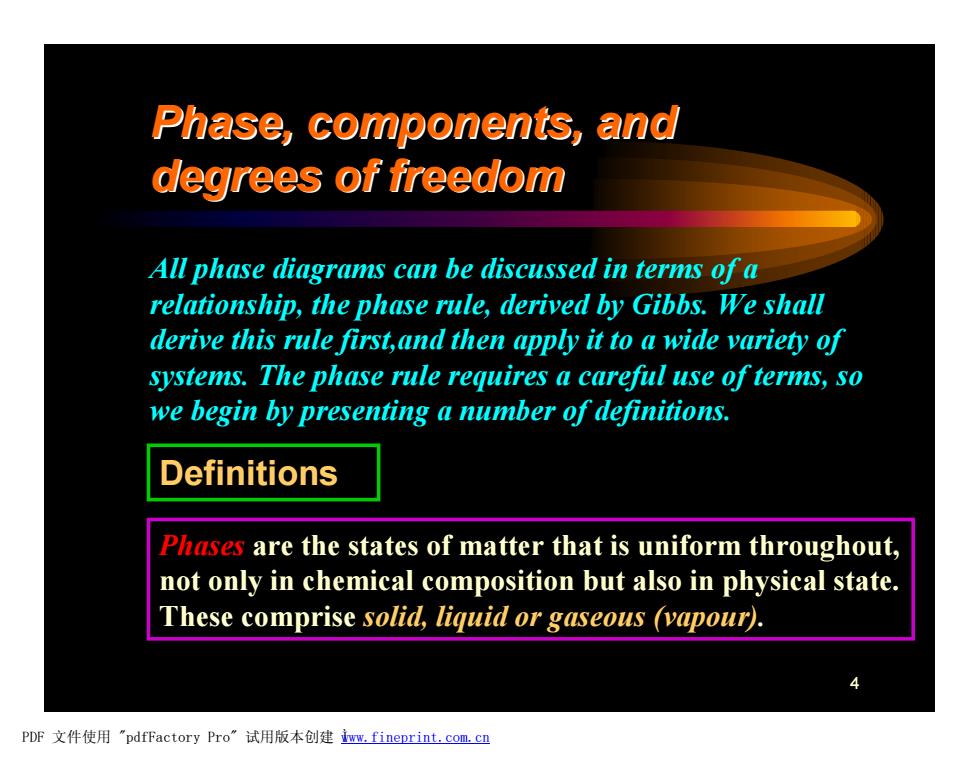
Phase Equilibrium 1 PDF文件使用"pdfFactory Pro”试用版本创建mm,fineprint.com,cn
1 Phase Equilibrium PDF 文件使用 "pdfFactory Pro" 试用版本创建 www.fineprint.com.cn

Introduction .Firstly,we introduce the famous phase rule of Gibbs which shows the extent to which various parameters can be varied yet the equilibrium between phases preserved. .With the rule established,we see how it can be used to discuss the phase diagrams.The chapter then introduces systems of gradually increasing complexity.In each case we shall see how the phase diagram for the system summarizes empirical observations on the conditions under which the various phases of the system are stable. 2 PDF文件使用"pdfFactory Pro”试用版本创建m,fineprint.com,cn
2 Introduction •Firstly, we introduce the famous phase rule of Gibbs ,which shows the extent to which various parameters can be varied yet the equilibrium between phases preserved. •With the rule established, we see how it can be used to discuss the phase diagrams. The chapter then introduces systems of gradually increasing complexity. In each case we shall see how the phase diagram for the system summarizes empirical observations on the conditions under which the various phases of the system are stable. PDF 文件使用 "pdfFactory Pro" 试用版本创建 Ìwww.fineprint.com.cn ÿ

Introduction .Why to learn this chapter? Phase diagrams are of considerable commercial and industrial significance,particularly for semiconductors, ceramics,steels,and alloys.They are also the basis of separation procedures in the petroleum industry and of the formulation of foods and cosmetic preparations. 3 PDF文件使用"pdfFactory Pro”试用版本创建wm,fineprint.com,cn
3 Introduction •Why to learn this chapter? Phase diagrams are of considerable commercial and industrial significance, particularly for semiconductors, ceramics, steels, and alloys. They are also the basis of separation procedures in the petroleum industry and of the formulation of foods and cosmetic preparations. PDF 文件使用 "pdfFactory Pro" 试用版本创建 Ìwww.fineprint.com.cn

Phase,components,and degrees of freedom All phase diagrams can be discussed in terms of a relationship,the phase rule,derived by Gibbs.We shall derive this rule first,and then apply it to a wide variety of systems.The phase rule requires a careful use of terms,so we begin by presenting a number of definitions Definitions Phases are the states of matter that is uniform throughout, not only in chemical composition but also in physical state. These comprise solid,liquid or gaseous (vapour). PDF文件使用"pdfFactory Pro”试用版本创建m,fineprint.com,c四
4 Phase, components, and degrees of freedom All phase diagrams can be discussed in terms of a relationship, the phase rule, derived by Gibbs. We shall derive this rule first,and then apply it to a wide variety of systems. The phase rule requires a careful use of terms, so we begin by presenting a number of definitions. Definitions Phases are the states of matter that is uniform throughout, not only in chemical composition but also in physical state. These comprise solid, liquid or gaseous (vapour). PDF 文件使用 "pdfFactory Pro" 试用版本创建 Ìwww.fineprint.com.cn

The number of phases in a system is denoted P (a)A gas,or a gaseous mixture is a single phase. P=1 (b)For a solid system,an alloy of two metals is a two-phase system(P=2)if the metals are immiscible,but a single-phase system(P=1)if they are miscible---a homogeneous mixture of the two substances---is uniform on a molecular scale. 5 PDF文件使用"pdfFactory Pro”试用版本创建ww,fineprint.com,cn
5 The number of phases in a system is denoted P (a)A gas, or a gaseous mixture is a single phase. P=1 (b) For a solid system, an alloy of two metals is a two-phase system(P=2) if the metals are immiscible, but a single-phase system(P=1) if they are miscible---a homogeneous mixture of the two substances---is uniform on a molecular scale. PDF 文件使用 "pdfFactory Pro" 试用版本创建 fwww.fineprint.com.cn